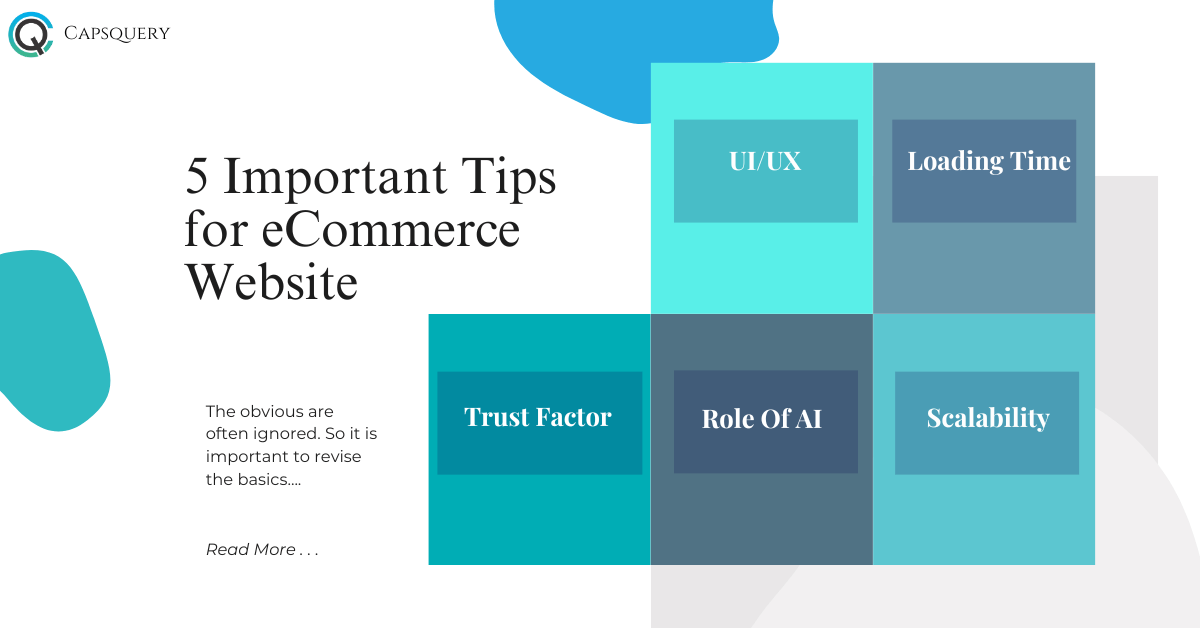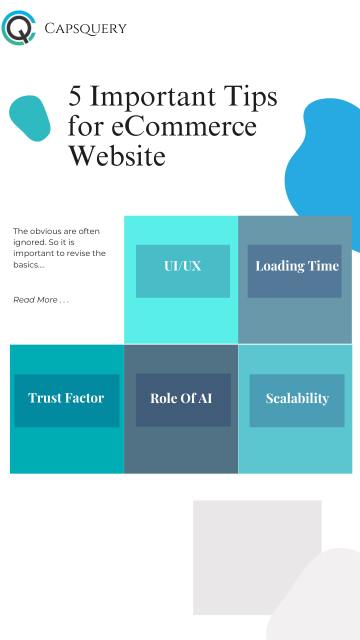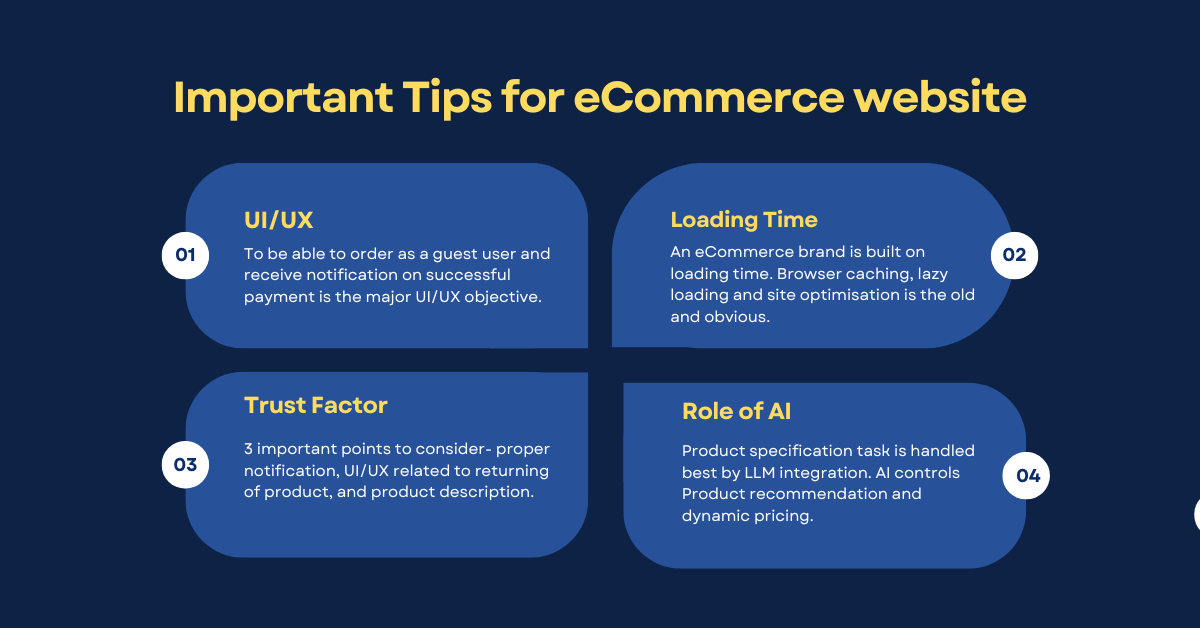



Sometimes we make silly mistakes, realize them later on, and repent. When we are engrossed in building something from the ground up and especially when we are in an inertia of creative spontaneity, we often miss the obvious. This blog will be a complete guide on 5 crucial web design tips for eCommerce websites:

The most important UX strategy in eCommerce is the ability to order as a Guest User. I recommend all my clients to keep it very simple: Phone Number (2FA), Email, Address, and done. User trust is very important and hence email/sms/WhatsApp communication for every submitted user action is important. The user actions include:
The ease of browsing products, adding products to a cart, and checking out by paying are the Goals. If we keep things simple so that users can easily switch between these screens: it results in a good UX. Another important factor for logged-in users is to able to manage orders, track orders, view order status. The ability to download invoices is also crucial.
Whether you are using an eCommerce theme or creating your own designs, the ability for users to navigate to any screen from any screen is vital.
If you have a page loading time a little less than the usual speed customers browse on another eCommerce shop, customers will lose trust in your platform. In 2025, improving loading time is not a secret. Here is a list of a few must-dos:
The method of Loading only the products that users can see in a single scroll on the first loaded screen, saves a lot of processing time. The products on the second, third, and remaining scrolls are then loaded one by one. This is a key web design technique for listing sites including eCommerce websites.
It is absolutely important to use a tool to optimize the product images and restrict them to a few KBs. You can use a simple filter like restricting users to upload images more than 50kb size. There can be another option where you can resize the image automatically.
Images, CSS, and JavaScript can be loaded from history using browser caching. So regular users can directlystart using the site without any new requests to the server for loading of images and page elements.
A good hosting plan is important. I will recommend using SSD storage for quick server response time. Another important factor is using HTTP/3 protocol over HTTP/2.
The majority of eCommerce customers shop from their mobile devices. It is very important to individually check the responsiveness of the main pages and overall site responsiveness in two different tasks.
The most crucial factor for running any successful business is customer trust. In eCommerce or any online business establishing customer trust is even more important. There are a few easy ways to comfort your client and buy their trust.
A timestamped notification for any submitted user action is important. The notification must be triggered via email, sms, and WhatsApp. User-action includes: Login (2FA), Account Creation, adding of the fund to the wallet, refund notification, redemption of the gift card, and shipment tracking notification in all steps of delivery
The ability for users to return product with ease using the system on their own is an absolute must. No users like to write emails to support and wait all day. So there needs to be a prominent action button in the site to return the product with an option for users to write why they are returning the product.
Product description including material/composition, dimension, multi-angle picture, video or any other vital specification is critical for the movement of the product. Any missing information does not skipthe attention of attentive eCommerce customers.
AI is a boast for any industry but for eCommerce websites, Artificial Intelligence has a special role to play. AI is already assisting eCommerce vendors with vital innovations. We will discuss 5 vital roles AI is playing in eCommerce sector.
Many eCommerce shop owners miss out on product optimization in terms of product name, description, specification, and images. It is quite common that a product remains unsold in the inventory due to insufficient product information.Therefore, AI is an important tool for recommending the right name for the right product and product description.
This is a basic and proven tool to boost sales and also assist your customers to land on the product they are looking for. Clustering of products is important. There are several factors to be considered for recommendation like order history, customer age, frequency, festivity, climate, cart value, etc. There are available plugins which is the easiest hack. You can design a custom recommendation engine based on custom parameters.
It is important to keep your inventory fast-paced to maximize profit. Often it happens a product remains stagnant in your inventory. You only find out after 3 months the actual reason for the stagnance: your competitor selling the same product at a discounted price. So it is important to keep a watch on the competitor pricing. Using an AI price recommendation, you can monitor competitor pricing as well as market demand and recommend a price.
AI Chatbot can help answer basic customer inquiries and can help retain customers. Therefore, you can implement an AI Chatbot in your online shop without a lot of investment and with a reasonably fair output.
Demand forecasting from historical sales data is probably the easiest task for an AI tool. Inventory preparedness is an absolute must to optimize profit. AI tools can make automatic reordering based on rules set by you from the admin back-end.
Scalability is the most important factor for eCommerce businesses.
Database architecture planning is crucial for an application. Proper table structure and envisioning future dependencies are important in creating database structure.
You must be able to scale your server size based on your requirements. You will always host your application in your own server space. This way you can become the true owner of an online shop. The popular hosting service providers are:
i. HostGator
ii. GoDaddy
iii. SiteGround
iv. Bluehost
v. Hostinger
Many ready-to-use application platforms, especially Shopify, tend to limit scalability and daily product upload capacity. However, there shouldn’t be any limit to the total number of products in the inventory.
If you want to add a new element that other template-based eCommerce platforms are not providing, you should be able to do it. There are many custom developers available who can create custom features. Example: removing the background of the image in a t-shirt design company. There can be custom pay-out structure, custom affiliation rules, custom forms with dynamic fields, etc. There should not be any restriction on custom features. As a business, there should not be any limit to your success. As a website owner, there should not be any limit to customisability.
To conclude, if we combine simplicity in UI/UX, build trust by notifying customers, use AI to meticulously improvise minute details, and provide unlimited scalability, we are pretty much into a good chance of reaching and connecting with the right customers. What do you think?
Sponser: webwinkeldesigner
Website Development | Mobile App Development | Application Development
We will definitely get back in touch with you over mail within 12 Hours.
In-case you have not heard from us within 12 hours, kindly check your spam once.
I'm a software consultant. I've 7+ years of industry experience. I'd love to connect with you and brainstorm your custom software needs. It's my responsibility to find you the best solution.
ANAND GUPTA
Drop your details and we'll get in touch with you within 12 hours.
Reach us for
Talk to us